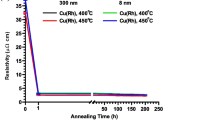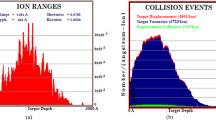Abstract
With the advent of copper metallization in interconnect structures, new barrier layers are required to prevent copper diffusion into the adjacent dielectrics as well as the underlying silicon. These barriers must not only prevent interdiffusion but also provide adequate adhesion to both the dielectric and copper. Ta and TaN have received considerable attention as barrier layers in copper metallization schemes. While much has been reported on their diffusion properties, little or no quantitative data exists on their adhesive properties. We present data on both the interface fracture energy and the subcritical debonding of ionmetal- plasma sputtered Ta and TaN films on thermal silicon oxide. Data is also presented showing the significant effect of interfacial chemistry, particularly varying nitrogen contents at the TaN/SiO2 interface.
Similar content being viewed by others
References
E. Kolawa, J. S. Chen, J. S. Reid, P. J. Pokela and M.-A. Nicolet, “Tantalum-based Diffusion Barriers in Si/Cu VLSI Metallizations,” J. Appl. Phys. 1991, 70 [3], 1369-73.
K. Holloway and P. Fryer, “Tantalum as a Diffusion Barrier Between Copper and Silicon,” Appl. Phys. Lett. 1990, 57 [17], 1736-38.
J. W. Hutchinson and Z. Suo, “Mixed Mode Cracking in Layered Materials.” Advances in Applied Mechanics, ed. J. W. Hutchinson and T. Y. Yu, (New York, Academic Press, 1991), 63–191.
A. G. Evans and J. W. Hutchinson, “Effects of Non-Planarity on the Mixed Mode Fracture Resistance of B imaterial Interfaces,” Acta. Metall., 1989, 37 [3], 909-16.
A. G. Evans, M. Ruhle, B. J. Dalgleish and P. G. Charlambides, “The Fracture Energy of Bimaterial Interfaces,”, Metall. Trans. A, 1990, 21A, 2419–2429.
A. Bhatnagar, M. J. Hoffman, R. H. Dauskardt, “The Effect of Environment on Subcritical Crack-Growth Behavior in Y-Si-Al-O-N Glasses,” Amer. Cerm. Soc., 1999. In review.
R. H. Dauskardt, M. Lane, Q. Ma and N. Krishna, “Adhesion and Debonding of Multi-Layer Thin Film Structures,” Eng. Fract. Mech. 1998, 61, 141-62.
M. Lane, R. H. Dauskardt, R. Ware, Q. Ma and H. Fujimoto, “Progressive Debonding of Mulit-Layer Interconnect Structures,” Proceedings of the 1997 MRS Spring Symposium, San Francisco, CA. Materials Reliability in Microelectronics VII, v 473, 21-6.
Q. Ma, “A Four-Point Bending Technique for Studying Subcritical Crack Growth in Thin Films and at Interfaces,” J. Mat. Res., 1997, 12, 840–45.
T. Michalske and B. Bunker, “Steric Effects in Stress Corrosion Fracture of Glass,” J. Am. Ceram. Soc. 1987, 70 [10], 780-84.
M. Lane and R. H. Dauskardt, analysis to be submitted for publication.
J. Mencik, “Strength and Fracture of Glass and Ceramics,” Elsevier Science Publishers, (1992).
R. Cook and E. Liniger, “Kinetics of Indentation Cracking in Glass,” J. AM Ceram. Soc. 76 [5] 1096-105 (1993).
M. Lane, N. Krishna and R. H. Dauskardt, unpublished data.
Author information
Authors and Affiliations
Rights and permissions
About this article
Cite this article
Lane, M., Dauskardt, R., Krishna, N. et al. Effect of Nitrogen Content on Interfacial Adhesion of the Ta/SiO2 Interface. MRS Online Proceedings Library 564, 281–286 (1999). https://doi.org/10.1557/PROC-564-281
Published:
Issue Date:
DOI: https://doi.org/10.1557/PROC-564-281




